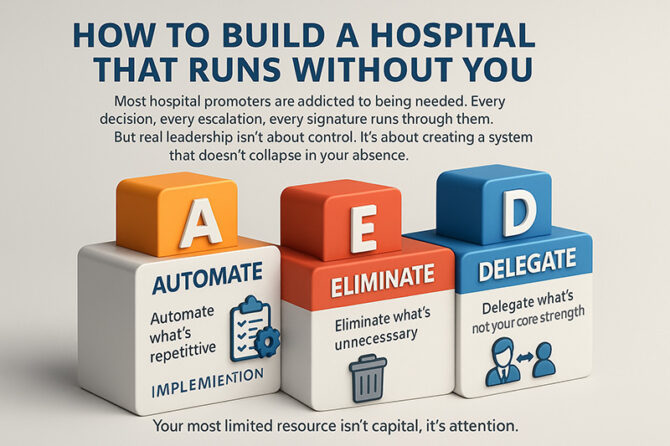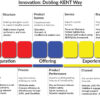
In the Indian scenario and other developing countries, the hospitals are usually designed around the founder. The founder becomes the primary nervous system in the organization. Every escalation, purchase, dispute, and signature eventually culminates in the hands of the founder. In the process, the leader becomes unwittingly “indispensable” and, in the process, the organization ceases to become a scalable, sustainable, and professionally managed system. As said by management guru Peter Drucker in “Management Challenges in the 21st Century,” “The leader of the past was a person who told. The leader of the future is a person who enables.”
One way leaders can effect this change is by using the AED Framework—Automate, Eliminate, and Delegate. The framework provides leaders an opportunity to eliminate firefighting and work on institution-building, and this process enables them to build an efficient and effective second line.
Automation has become an essential part of the operations in the health industry. The National Digital Health Blueprint, designed by the government in India, asserts the effectiveness of digitization in making operations more efficient, eliminating discrepancies, and ensuring uniform treatment.
By automating the routine and predictable activity related to patient registration, billing, medical templates, purchasing verifications, inventory cycles, and even the marketing and feedback systems in hospitals, administrators are freed from the minutiae. Indian success stories, such as the Narayana Health model, highlight the dramatic differences achievable through the automation of intensive care unit dashboards, paperless medical records, and completed discharge systems. In Devi Shetty’s writing on the subject, the role of technology in enabling the withdrawal of the promoter’s hands, even as they remain in command through real-time monitoring, has been outlined.
However, automation means an initial spend, change management, and upgrading, all things smaller hospitals need to factor in. But the long-term gains in terms of fewer mistakes, smoother functioning, and patient satisfaction make all the travails worthwhile. When the founders don’t need to intervene in each and every operation, they get back their most valuable resource – their attention.
Elimination forms the second foundation under the AED model. Hospitals build up wastages over time in the form of unnecessary registers, unnecessary signatures on trivial transactions, unnecessary committees, and unnecessary process routing that has ceased to conform either to NABH norms, in the past, or with the latest technology in terms of EMRs. Here, Jim Collins, in “Good to Great,” observes, “A great organization is not defined by what it adds, but by what it removes.” In India, most hospitals even now use the manual register, despite the use of the EMR, and have an outdated MDC that exists on paper.
The application of Lean Healthcare, written about in BMJ Quality and Safety and The Journal of Healthcare Management, means the elimination of waste, whether related to time, movement, process, and approval, in order to create this hidden capacity without necessarily adding people. There would be need for the leadership to be brave in the process because, in most cases, it means confronting the past, negotiating with senior colleagues, and re- engineering work processes.
The third, and most psychological, step in the process of promoting hospitals is delegation. While the founders themselves are initially intimidated by the prospect of delegation because they fear the risk of mismanagement, lack of control, compromising quality, and irregular finances, the truth, however, indeed, is that all the powers cannot be in the hands of the developer alone, because hospitals cannot expand in that manner. Michael Gerber, in “The E-Myth Revisited,” says, “A business is run through systems, not through the individual’s personal touch.”
Delegation means assigning tasks and roles to experts. The finance, management and operation, HR and payroll, purchasing and inventory management, and quality awareness can be efficiently dealt with by the services of an accountant/CFO, the HR head, the materials manager, and the quality leader, respectively. When the other activities like the scheduling of shows, communication, digital marketing, and the compliance process are carried out by experts, the promoter can then concentrate on the strategic alignment, the relationship and the technology adoption.
The fact that Indian hospitals like Apollo, Aster, and Manipal were successful in their own right was because they created a strata leadership approach, where leadership was distributed and power was neither concentrated in the hands of the administrator alone nor in the hands of the doctors. Globally, the Mayo Clinic model of leadership, where the medical director, the nursing director, and the administrative director all share the same power over decision-making, has long become an established one in medical journals like the Mayo Clinic Proceedings. But what all these pillars rest on is the truth that the most valuable resource founders lack access to, after all, isn’t cash—it’s attention. Hospitals tend to shut down, not because they lack funds, but because the entrepreneur gets bogged down in minutiae rather than attending to important things.
Cal Newport, in “Deep Work,” asserts, “Clarity is the new superpower in a world full of noise.” Having an organization like a hospital that operates even in the absence of the constant involvement of the promoter would be not only convenient, it would be a sign of a mature, scalable, and future-oriented organization. Constructing an organization like this does not downgrade the role of the promoter; rather, it escalates it because the leader would now have the ability and the chance to build, excel, and leave legacies. The endgame here would be developing an organization that can run properly even when the promoter takes a break, whether in terms of a week, a month, or a year.
Dr. Prahlada N.B
MBBS (JJMMC), MS (PGIMER, Chandigarh).
MBA in Healthcare & Hospital Management (BITS, Pilani),
Postgraduate Certificate in Technology Leadership and Innovation (MIT, USA)
Executive Programme in Strategic Management (IIM, Lucknow)
Senior Management Programme in Healthcare Management (IIM, Kozhikode)
Advanced Certificate in AI for Digital Health and Imaging Program (IISc, Bengaluru).
Senior Professor and former Head,
Department of ENT-Head & Neck Surgery, Skull Base Surgery, Cochlear Implant Surgery.
Basaveshwara Medical College & Hospital, Chitradurga, Karnataka, India.
My Vision: I don’t want to be a genius. I want to be a person with a bundle of experience.
My Mission: Help others achieve their life’s objectives in my presence or absence!
My Values: Creating value for others.
Leave a reply
















Dear Dr. Prahlada N.B Sir,
Your article on creating a hospital that runs without your involvement is a masterclass in leadership and vision. As you so eloquently put it, "The leader of the past was a person who told. The leader of the future is a person who enables." This quote resonates deeply, and I couldn't agree more.
Building an organization is like nurturing a tree. You plant the seed, water it, and provide it with the right environment to grow. But as it grows, you must prune it, allowing it to branch out and flourish on its own. If you cl hold onto it too tightly, it will never reach its full potential.
The AED Framework (Automate, Eliminate, and Delegate) is a brilliant approach to achieving this. Automation is like the roots of the tree, providing stability and nourishment. Elimination is like pruning, removing the unnecessary to make way for growth. And Delegation is like empowering the branches to reach for the sky.
I recall a quote from Jim Collins, "A great organization is not defined by what it adds, but by what it removes." Your article beautifully illustrates this concept, showing how removing unnecessary processes and empowering teams can lead to a more efficient and effective organization.
Your vision for KENTH & RC (R) is inspiring, and I'm sure it will continue to be a beacon of excellence in healthcare. As you said, "The most valuable resource founders lack access to, after all, isn't cash – it's attention." Your ability to focus on the bigger picture, while empowering your team to handle the day-to-day, is a testament to your exceptional leadership.
Thank you for sharing your insights, Sir. Your words will undoubtedly inspire many leaders to rethink their approach and build organizations that can thrive without their constant involvement.
Reply